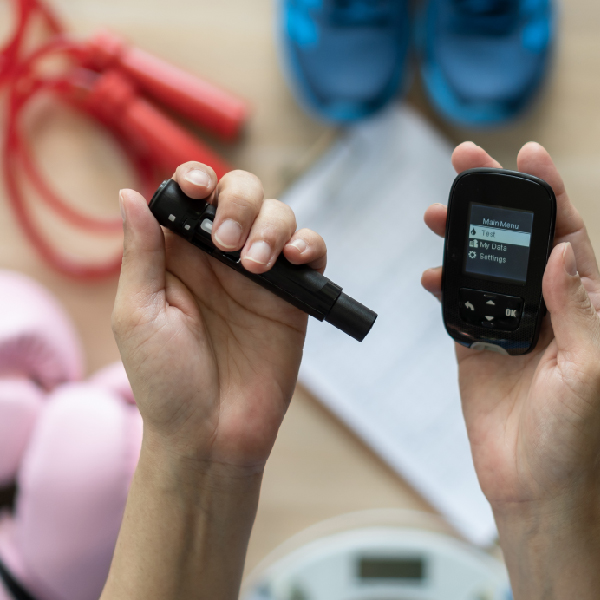— Dawn M. Sweet, Ph.D.
Working out in Zone 2 can help optimize weight loss by burning more fat, which will can mitigate the risks of type 2 diabetes.
Exercise has many goals, namely increasing endurance, strength, balance, and flexibility. Perhaps one of the most popular goals for exercising — if not the most popular goal — is weight loss. Living at a healthy weight confers health advantages, while living at an unhealthy weight elevates health risks.
Persons with obesity are at an increased risk of developing cardiovascular disease, stroke, and type 2 diabetes.1 For persons with obesity and type 2 diabetes, these health risks are significantly increased and expand to include high blood pressure, metabolic syndrome, fatty liver disease, and cancer, to name only a few.2 Given the elevated health risk, losing weight is a critical strategy. Understanding how our bodies are functioning in different heart rate zones can help optimize weight loss and subsequently help mitigate the risks of type 2 diabetes
What are Heart Rate Zones and Why Do They Matter?
A heart rate zone is a way to categorize the intensity of exercise relative to your heart rate. It’s important to know your maximum heart rate3 (220 – your age) because everyone’s heart rate zones are based on this value. For example, the maximum heart rate for a 50-year-old is 220 – 50 = 170. This means that this person’s heart rate should not exceed 170 beats per minute when exercising. The intensity at which you work out is driven by your maximum heart rate, and the intensity at which you work out determines whether you are burning fat, carbohydrates, or sugar as fuel.
Hear rate zones are measured in terms of your maximum heart rate and have been categorized into 5 zones:
- Zone 1: 50 – 60 percent of your maximum heart rate. This zone requires the least amount of effort and is typically the goal for warming up before exercising and cooling down following exercising. Your body burns fat as fuel at this state, but it is negligible.
- Zone 2: 60 – 70 percent of your maximum heart rate. This zone is for moderate-intensity exercise. When in this zone you should be able to sustain a conversation. Zone 2 is considered a fat-burning zone; your body is drawing on stored fat for energy. This zone is ideal for building endurance and aerobic fitness.
- Zone 3: 70 – 80 percent of your maximum heart rate. This zone is for higher intensity exercise and relies on fat and carbohydrates for energy. In this zone you are building cardiovascular fitness and aerobic capacity.
- Zone 4: 80 – 90 percent of your maximum heart rate. This zone is more challenging for your cardiovascular system and is considered anaerobic; your body is relying on glucose that is stored in muscle for energy. Exercise in this zone builds lean mass. Exercise in this zone cannot be sustained for extended periods of time. This zone is about short, intense burst of effort.
- Zone 5: 90 – 100 percent of your maximum heart rate. This zone is near your maximum effort and is sustainable for only a few seconds at a time, or perhaps a few minutes if you are an elite athlete or someone who is in peak physical condition.
To calculate your heart rate for any of the 5 zones, use the following formula multiple your maximum heart rate by the lower and upper percentage of effort in that zone. For example, if you are 50 years old and want to work out in Zone 2, you need to multiply your maximum heart rate by 60 percent and 70 percent to derive your range.
- 220 – 50 = 170 * .6 = 102 bpm
- 220 – 50 = 170 * .7 = 119 bpm
- Zone 2 = 102 – 119 beats per minute
Fat Burning Zone for Persons with Obesity and Type 2 Diabetes
For persons with obesity and type 2 diabetes, Zone 2 is the optimal zone because this is the zone where fat is being burned as energy. When there is excess fat, particularly visceral fat (the “invisible fat” behind the abdominal wall and surrounding organs) we become insulin resistant. This means that our bodies are not efficiently taking the glucose (sugar) from our bloodstream and moving it to our muscle, fat, and liver cells to be used as energy later. Insulin resistance leads to increased glucose levels in the blood, a common problem for patients with type 2 diabetes. Exercising in the fat burning zone can increase insulin sensitivity, which allows our bodies to use insulin more efficiently.
Exercising in Zone 2 can lead to an increase in energy expenditure (e.g. calories burned), because the low intensity means you can sustain the effort for a longer period of time. You can certainly burn calories in Zones 3 and above, but you are not burning as much fat, which is important for patients with obesity and type 2 diabetes.
Zone 2 puts less strain on your joints because of its low impact, another benefit for patients with obesity. Activities in Zone 2 include walking at a brisk pace, cycling, or swimming. You should be able to comfortably carry on a conversation in Zone 2 (unless you are swimming laps in the pool!).
Building endurance and aerobic capacity are other benefits of working out in Zone 2. Working out at a lower intensity for a longer period of time will improve your aerobic base. Because you can sustain the activity for longer periods of time, you are building endurance. Zone 2 also offers cardiovascular benefits because it can strengthen your heart and improve circulation, reducing your risk of cardiovascular disease associated with type 2 diabetes. A healthy cardiovascular system will ultimately support overall weight loss efforts via exercise in the present and in the future.
The American Heart Association4 recommends 150 minutes of moderate exercise per week. Because Zone 2 is lower intensity, your goal should be 60 minutes twice per week in Zone 2 to jumpstart fat burning and to build an aerobic base. If 60 minutes of low intensity is not possible, begin with 5 minutes, or 10 minutes or 20 minutes, depending on your current level of physical conditioning. As you exercise, your endurance will increase, and you can begin to add 5 or 10 minutes to your exercise sessions each week until you can comfortably and safely sustain 60 minutes of effort in Zone 2.
Work with your health care provider to determine the best way for you to begin an exercise program.
Sources:
1 American Diabetes Association: Extra Weight, Extra Risk
2 National Institutes of Health: Health Risks of Overweight and Obesity
3 Cleveland Clinic: How To Check Your Pulse
4 American Heart Association Recommendations for Physical Activity in Adults and Kids
About the Author: Dr. Dawn M. Sweet has over 20 years of experience in the field of communication. Sweet has given several invited talks to and workshops for academic and private sector audiences on the role of nonverbal and verbal communication in achieving positive outcomes and mitigating bias. Her research has been published in several top ranked peer-review journals, and it has been featured on NPR’s River to River / All Things Considered, Buzzfeed, and Science Daily. Her research has also been used to inform expert testimony.





